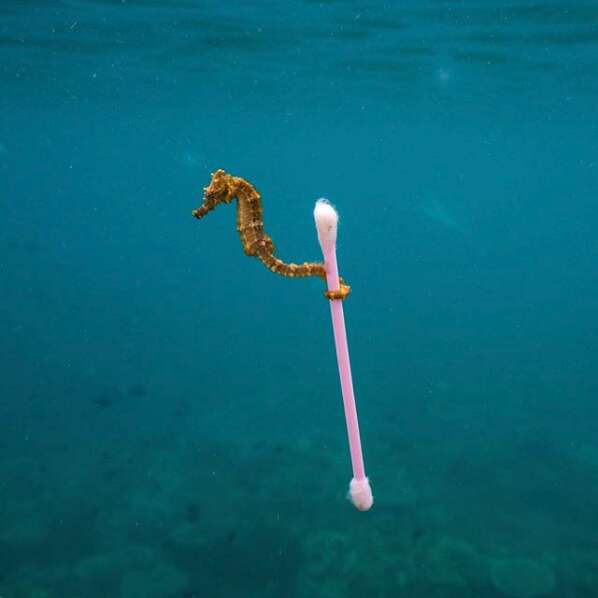
It should have been a moment of wonder.
While snorkeling off an island south of Borneo, wildlife photographer Justin Hofman drifted through warm waters, watching the sway of corals and the flicker of reef fish. Then he noticed her—a tiny orange seahorse, delicate as a child’s drawing, bobbing in the tide. She clung to drifting strands of seagrass, moving gracefully in the current, her fragile body only a few centimeters long.
For a moment, Hofman thought he’d stumbled upon the perfect photograph: a creature as iconic as it was impossibly small, suspended in a turquoise sea. But then the tide shifted, and with it came something else—an incoming wave of human neglect.
Plastic bags. Wrappers. A sheen of sewage. The smell of waste clung to the salt water. And among the debris, the little seahorse could do nothing but adapt.
“She went from one piece of trash to another,” Hofman recalled. “It was literally sewage; you could smell the water change. It was disgusting.”
At last, she grasped a floating plastic cotton swab, her tail curling tightly around it as though it were driftwood. The sight was jarring—an animal millions of years old, designed by nature for beauty and survival, now forced to cling to a symbol of human convenience.
Hofman raised his camera. The shutter clicked. And with it, an image was captured that he wished had never existed.
When he shared the photograph online, the response was immediate. It went viral, spreading across social media, news outlets, and conservation groups. Soon, it was named a finalist in the prestigious Wildlife Photographer of the Year exhibition at London’s Natural History Museum.
But Hofman wasn’t seeking fame. He wasn’t proud of this image the way he was with others that celebrated wilderness untouched. This picture was different. It was painful.
“It’s a photo that I wish didn’t exist,” Hofman admitted, “but now that it does, I want everyone to see it.”
The seahorse and the cotton swab became a symbol of something larger: the invasion of plastic into every corner of the ocean. From the deepest trenches to the most remote reefs, microplastics and debris are now part of the ecosystem. What began as a single-use product in human hands ends as a permanent threat in fragile habitats.
For Hofman, the lesson was clear. This wasn’t just about one seahorse—it was about all of us.
“I hope it helps people think about what they consume,” he said. “Choosing paper instead of plastic. Not letting trash go down the drain. Putting things in bins and recycling. If every person did their part, it would add up to a huge impact.”
Some viewers saw only despair in the image: a fragile life overwhelmed by pollution. But Hofman insists the photograph can also be a call to action. “People might look at the picture and think, ‘We’re doomed.’ But we’re not. We can do something. We just have to decide it matters.”
That day in Borneo, the tide eventually carried the little seahorse beyond Hofman’s reach. But the image of her tiny body wrapped around a plastic swab remains—an emblem of fragility, a mirror reflecting our choices back at us.
The seahorse did what she could: adapt, cling, survive.
The question is whether we will do the same—choosing change, before the tide overwhelms us too.




